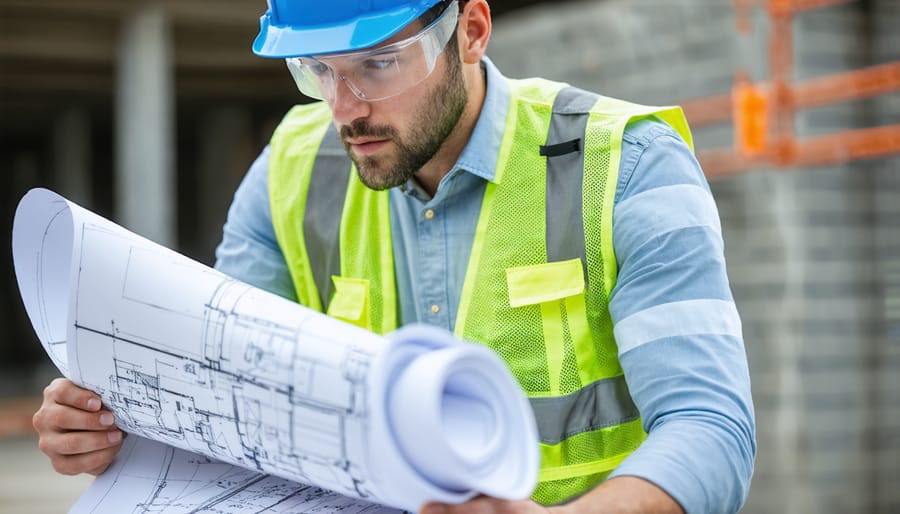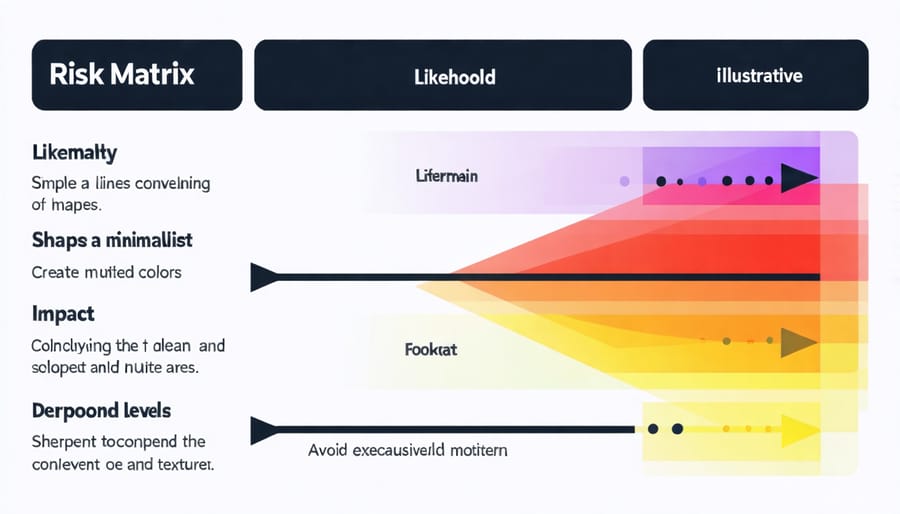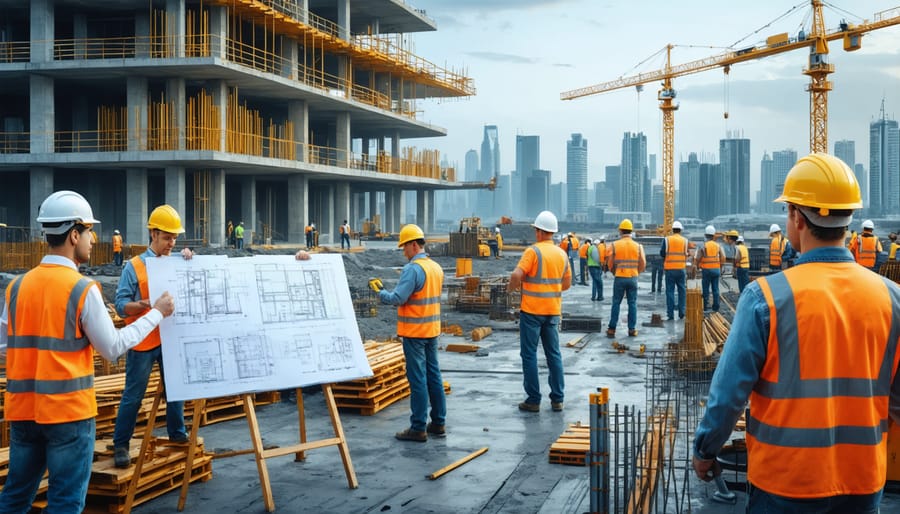Identify, assess and prioritize risks early in project safety planning. Develop risk mitigation strategies tailored to each threat’s potential impact and likelihood. Continuously monitor project progress to swiftly detect emerging risks and implement corrective actions. Foster a risk-aware culture through regular team communication and training on proactive risk management best practices.

Identify and Assess Potential Risks
Project-Specific Risk Assessment
Each construction project faces unique risks based on factors like location, scope, and stakeholder requirements. To effectively assess these project-specific risks, construction managers can employ techniques such as:
1. Conducting thorough site investigations to identify potential hazards related to soil conditions, environmental factors, and surrounding structures.
2. Analyzing project documentation, including contracts, plans, and specifications, to uncover risks associated with design, materials, or construction methods.
3. Engaging in stakeholder interviews and workshops to gather insights on potential risks from various perspectives, including owners, architects, engineers, and subcontractors.
4. Utilizing risk assessment tools like the Failure Mode and Effects Analysis (FMEA) or the Hierarchical Risk Breakdown Structure (HRBS) to systematically identify and prioritize project-specific risks.
5. Developing risk registers tailored to each project, which document identified risks, their likelihood and impact, and proposed mitigation strategies.
By employing these techniques, construction managers can develop a comprehensive understanding of the unique risk landscape for each project, enabling them to create targeted risk management plans that address project-specific challenges effectively.
Quantifying and Prioritizing Risks
To effectively prioritize risks, construction managers must quantify both the potential impact and likelihood of each identified risk. Impact can be measured in terms of cost, schedule delays, safety incidents, or quality issues. Likelihood is typically assessed using historical data, expert judgment, and statistical analysis.
One common method is to assign numerical scores to impact and likelihood, then multiply them to determine a risk priority number. Risks with higher priority numbers demand more immediate attention and resources for mitigation. Another approach is to plot risks on a matrix with impact and likelihood as the axes, visually highlighting the most critical risks.
Quantitative risk analysis techniques, such as Monte Carlo simulations, can provide more precise estimations of risk exposure. These methods help determine contingency budgets and schedules. Ultimately, the prioritization of risks should align with the project’s overall goals and stakeholder expectations. Regular review and updates to risk assessments are crucial as project conditions change.

Develop a Comprehensive Risk Management Plan
Developing a comprehensive risk management plan is crucial for the success of any construction project. The plan should identify potential risks, assess their likelihood and impact, and outline strategies to mitigate or respond to them. Start by conducting a thorough risk assessment, involving all stakeholders to identify risks across all project areas, including technical, financial, legal, and environmental aspects.
Once risks are identified, prioritize them based on their probability and potential impact. Develop specific mitigation strategies for high-priority risks, which may include transferring risk through insurance or contracts, reducing risk likelihood through process improvements, or accepting certain risks when the cost of mitigation outweighs the benefits.
Your risk management plan should also establish clear roles and responsibilities for risk monitoring and response. Regularly review and update the plan throughout the project lifecycle, as new risks may emerge or priorities change. Effective communication and collaboration among project team members, stakeholders, and external partners are essential for successful risk management.
Incorporating risk management into your project governance structure, such as regular risk review meetings and reporting, ensures that it remains a top priority. By proactively identifying and managing risks, construction professionals can minimize their impact on project objectives, timelines, and budgets, ultimately leading to more successful project outcomes.

Implement Risk Mitigation Techniques
Insurance Coverage for Construction Risks
Insurance coverage is a crucial risk mitigation strategy in construction management. Several types of insurance policies can help protect against financial losses resulting from various construction risks. General Liability Insurance covers third-party claims for property damage or bodily injury caused by the contractor’s operations. Professional Liability (Errors & Omissions) Insurance protects against claims arising from professional negligence or design errors. Builder’s Risk Insurance provides coverage for damage to the structure under construction due to perils such as fire, theft, or weather events. Workers’ Compensation Insurance is mandatory in most jurisdictions and covers medical expenses and lost wages for employees injured on the job. Surety Bonds, while not technically insurance, provide financial guarantees that contractors will fulfill their contractual obligations. Umbrella or Excess Liability Insurance provides additional coverage beyond the limits of primary policies. Carefully reviewing and selecting appropriate insurance coverage, tailored to the specific risks of each construction project, is essential for effectively managing potential financial impacts and protecting the interests of all stakeholders involved.
Contingency Planning and Risk Reserves
Contingency planning and risk reserves are crucial components of effective risk management in construction projects. By proactively developing backup plans and allocating funds for potential risk events, construction managers can minimize the impact of unforeseen circumstances on project timelines, budgets, and overall success.
Thorough contingency plans should be created for each identified risk, outlining specific actions to be taken if the risk materializes. These plans should be communicated to all relevant stakeholders and regularly reviewed and updated as project conditions change. Having well-defined contingency plans in place allows teams to respond swiftly and effectively when challenges arise, minimizing delays and additional costs.
Establishing risk reserves is another essential aspect of contingency planning. These financial reserves, typically a percentage of the total project budget, serve as a buffer against unexpected expenses resulting from realized risks. The size of the risk reserve should be determined based on the likelihood and potential impact of identified risks, as well as the organization’s risk tolerance. By adequately budgeting for risk events, construction managers can ensure that projects remain financially viable even in the face of adversity.
Ultimately, investing time and resources into contingency planning and risk reserves positions construction projects for success by enhancing resilience and adaptability in the face of inevitable challenges.
Foster a Risk-Aware Project Culture
Fostering a risk-aware project culture is essential for effective risk management in construction projects. All stakeholders, including project managers, contractors, subcontractors, and clients, must be actively involved in the risk management process. Encouraging open communication and collaboration among team members helps identify potential risks early on and develop proactive mitigation strategies. Regular risk assessment meetings and workshops can help raise awareness about project risks and promote a shared responsibility for managing them.
Effective stakeholder engagement is key to building a risk-aware culture. Project managers should communicate the importance of risk management to all stakeholders and provide them with the necessary tools and training to actively participate in the process. By involving stakeholders in risk identification, assessment, and decision-making, project managers can tap into their collective knowledge and expertise, leading to more comprehensive and effective risk management strategies.
Moreover, promoting a culture of transparency and accountability encourages stakeholders to report potential risks promptly without fear of repercussions. This enables project managers to address risks before they escalate into major issues that can impact project timelines, budgets, and quality. By fostering a risk-aware project culture, construction professionals can create a proactive and resilient environment that enhances project success and minimizes the impact of potential risks.
Monitor and Review Risks Regularly
Effective risk management in construction projects requires continuous monitoring and regular reviews throughout the project lifecycle. By staying vigilant and proactively assessing risks at each stage, construction managers can quickly identify new risks, track the effectiveness of mitigation strategies, and adapt their risk management plans as needed.
One key technique for ongoing risk monitoring is establishing clear metrics and key performance indicators (KPIs) that align with project objectives. These metrics may include financial indicators, schedule milestones, safety statistics, and quality control measures. By regularly tracking and analyzing these KPIs, construction managers can identify potential risk factors and take corrective action before issues escalate.
Another essential aspect of risk monitoring is maintaining open communication channels with all project stakeholders, including the client, design team, subcontractors, and on-site personnel. Encouraging a culture of transparency and collaboration allows for the early identification and reporting of potential risks, enabling the project team to address concerns proactively.
Conducting regular risk review meetings is also crucial for effective risk management. These meetings provide an opportunity for the project team to reassess identified risks, evaluate the effectiveness of mitigation strategies, and discuss any new risks that have emerged. By involving key stakeholders in these discussions, construction managers can leverage collective expertise to develop comprehensive risk management solutions.
Additionally, leveraging technology can significantly enhance risk monitoring capabilities. Construction management software, real-time data collection tools, and advanced analytics platforms can help project teams track risk factors, monitor progress, and identify trends that may indicate potential issues. By harnessing the power of technology, construction managers can make data-driven decisions and respond to risks more effectively.
Ultimately, the success of risk monitoring and review in construction projects relies on a proactive, collaborative approach that prioritizes ongoing communication, data-driven decision-making, and a commitment to continuous improvement. By embedding these practices into the project lifecycle, construction managers can minimize the impact of risks and deliver successful projects that meet stakeholder expectations.
Leverage Technology for Risk Management
In today’s digital age, leveraging technology is essential for effective risk management in construction projects. Advanced software solutions and digital tools are transforming the way construction professionals identify, assess, and mitigate potential risks. These technologies enable real-time data collection, analysis, and collaboration, empowering project teams to make informed decisions and respond swiftly to emerging threats.
One such tool is Building Information Modeling (BIM) software, which creates a digital representation of the physical and functional characteristics of a construction project. BIM allows for early detection of design clashes, constructability issues, and potential safety hazards, enabling proactive risk mitigation. Additionally, project management software with integrated risk management modules helps teams track and monitor risks throughout the project lifecycle, ensuring that no critical issues fall through the cracks.
Other technologies, such as drones and 3D scanning, provide valuable data for risk assessment. Drones can survey construction sites, capturing high-resolution images and videos that can be analyzed to identify potential hazards or quality issues. 3D scanning technology creates accurate digital models of existing structures, helping to detect any deviations from the original design or potential risks associated with renovation projects.
Moreover, the rise of artificial intelligence (AI) and machine learning (ML) is revolutionizing risk management in construction. AI-powered algorithms can analyze vast amounts of historical data to predict potential risks and suggest optimal mitigation strategies. These intelligent systems continuously learn from new data, improving their accuracy and effectiveness over time.
By embracing these cutting-edge technologies, construction professionals can significantly enhance their risk management capabilities, ultimately leading to safer, more efficient, and successful projects.
Conclusion
In conclusion, effective risk management is a critical component of successful construction project delivery. By proactively identifying, assessing, mitigating, and monitoring risks, construction professionals can minimize the impact of potential issues on project timelines, budgets, and quality. Implementing a structured risk management process, fostering open communication among stakeholders, and leveraging advanced tools and techniques can significantly improve project outcomes. Construction managers who prioritize risk management are better equipped to navigate the complex challenges inherent in the industry, ultimately leading to increased profitability, enhanced reputation, and greater client satisfaction. As the construction industry continues to evolve, adopting a proactive approach to risk management will remain essential for staying competitive and delivering projects that meet or exceed expectations. By embracing the strategies and best practices outlined in this article, construction professionals can take their risk management efforts to the next level and set themselves up for long-term success.

